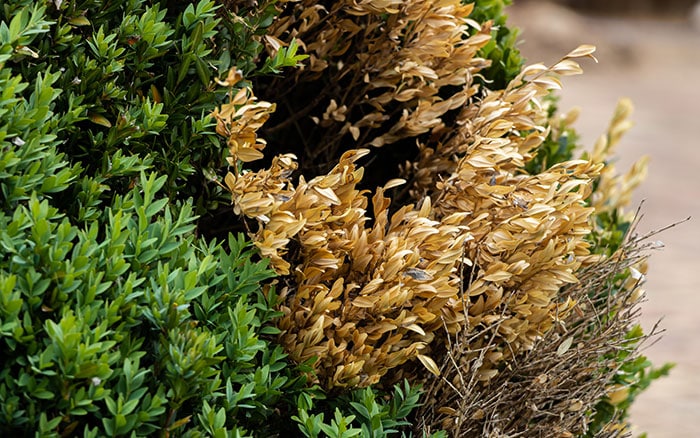A common fungal disease amongst Buxus sempervirens plants, find out how to identify and control Box Blight.
What is Box Blight
This is a disease caused by two similar fungi: Calonectria pseudonaviculata and Calonectria henricotiae. They infect the stems and the leaves, which can lead to the hedge being left with severe dieback.
Box Blight was first identified affecting Buxus sempervirens plants in the UK back in 1998. Since then, it has spread throughout the UK and become a growing problem amongst Box hedge growers.
The fungal disease is seen commonly in Buxus sempervirens plants, but does affect other plants in the Bucaceae family. These include Buxus, Haptanthus, Sarcococca, Didymeles, Pachysandra and Styloceras plants.
How to spot Box Blight
The first signs of box blight are leaves turning brown after dark lesions appear, which will eventually fall off. This will leave stems bare. You might also notice young stems developing black streaks, and spores on the undersides of leaves that are infected.
It is worth knowing the difference between this, and the symptoms of Box Moth Caterpillar. This too features dieback and yellowing leaves, but you won’t find spores. Box Moth Caterpillar also leaves behind webbing where it has been feeding, but you won’t find this with Box Blight.


How to control Box Blight
Taking measures to prevent your Buxus from contracting Box Blight is a good first step. If you have recently purchased some commercial Box hedge plants, consider keeping them isolated from any other plants for a few weeks, before planting them out. This would allow you plenty of time to identify any telling symptoms.
Make sure you reduce how regularly you prune your hedges too. Pruning them often encourages the foliage and stems to grow tighter. This can create the perfect environment for the fungal disease to spread. Instead, prune less frequently to allow more ventilation into your plant. After pruning, clean your tools too, to avoid spreading spores from one plant to another.
Water your box hedge plants from lower down rather than overhead, to avoid creating the perfect humid conditions amongst the leaves.


If your plant is already infected, catching it early is the key, so make sure to check your Box hedges regularly. If you see any sign of the disease, cut out the affected branches and destroy them – don’t add them to your compost bin. Any infected fallen leaves should also be treated the same way.
If the hedge is severely infected, the best course of action is to dig it up and destroy it. At this point, perhaps try an alternative to box hedge, rather than replacing with a new Buxus sempervirens plant.
Need advice?
If you need specialist advice, I would always recommend you speak to your local garden centre, plant nursery or contact the advisory service of the Royal Horticultural Society. Each of these organisations has expert knowledge that can make pest and disease control so much easier. And when speaking to a garden centre or nursery that is local to you, the chances are they will know whether there has been an influx in pests too.

Leave A Comment